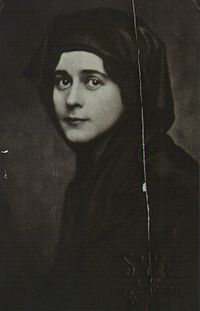Marianna Török
| Marianna Török | |||||
|---|---|---|---|---|---|
| Countess Török von Szendrö | |||||

Countess Marianna wearing an Islamic veil
|
|||||
| Born |
June 15, 1877 Philadelphia, PA, United States |
||||
| Died | August 5, 1968 (aged 91) Graz, Austria |
||||
| Burial | Cemetery of St. Leonhard, Graz, Austria | ||||
| Spouse | Arthur, Freiherr von Klingspor Abbas Hilmi II (m. 1910; div. 1913) |
||||
|
|||||
| Father | József, 3rd Count Török de Szendrő | ||||
| Mother | Sofie, Gräfin Vetter von der Lilie | ||||
| Religion | Sunni Islam (by conversion) | ||||
| Occupation | Pianist writer Interpreter Painter |
||||
| Signature | |||||
| Full name | |
|---|---|
|
Birth name: Marianne May Arabic name: Djavidan Hanem Arabic: جاويدان هانم |
Marianna Török de Szendrő (German: May Torok von Szendro; June 15, 1877 in Philadelphia, US – August 5, 1968 in Graz) was a Hungarian noble, second spouse of the Khedive Abbas II of Egypt.
Marianna was the daughter of Sofie, Countess Vetter von der Lilie, and stepdaughter of Hungarian inventor Tivadar Puskás. She spent most of her youth at Wassen Castle, south of Graz, Austria. At age 12, she allegedly wrote short articles for various journals and played the piano. Her elder brother Count József Török de Szendrő (1873–98), following Austrian tradition, was enrolled at the Theresianum, where he befriended Abbas Bey, an Egyptian prince. Marianna and Abbas met at a ball given by the academy. Shortly thereafter, he was made ruler in Egypt. They met the second time in Paris in 1900, where they fell in love, and Abbas invited her to Egypt.
The visit developed into a long romance culminating into a secret marriage contracted in Alexandria's Montazah Palace, witnessed by two sheiks. The official marriage took place on February 28, 1910, with the Grand Mufti of Egypt officiating. Marianna converted to Islam in the presence of the Grand Mufti. She was then called Princess Djavidan Hanem, wife of the Khedive of Egypt. Abbas was separated from his first spouse, Ikbal Hanem, a former slave in his mother's household.
Khedive Ismail Pasha was the last ruler of Egypt to have a harem, and upon his departure, the büyük (elder), ortangı (middle) and küçük (small) harems, as well as the aghas (eunuchs) became out of use, and the custom at the Egyptian court had become one consort, until now. The marriage was controversial.
...
Wikipedia
